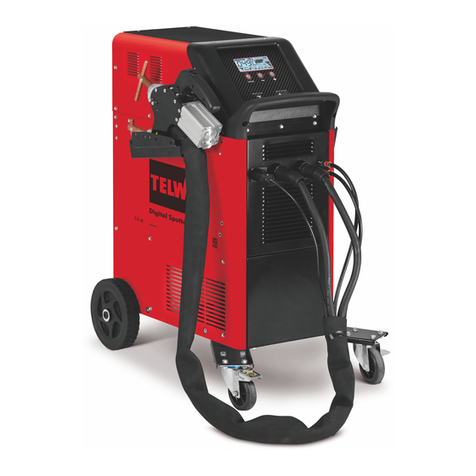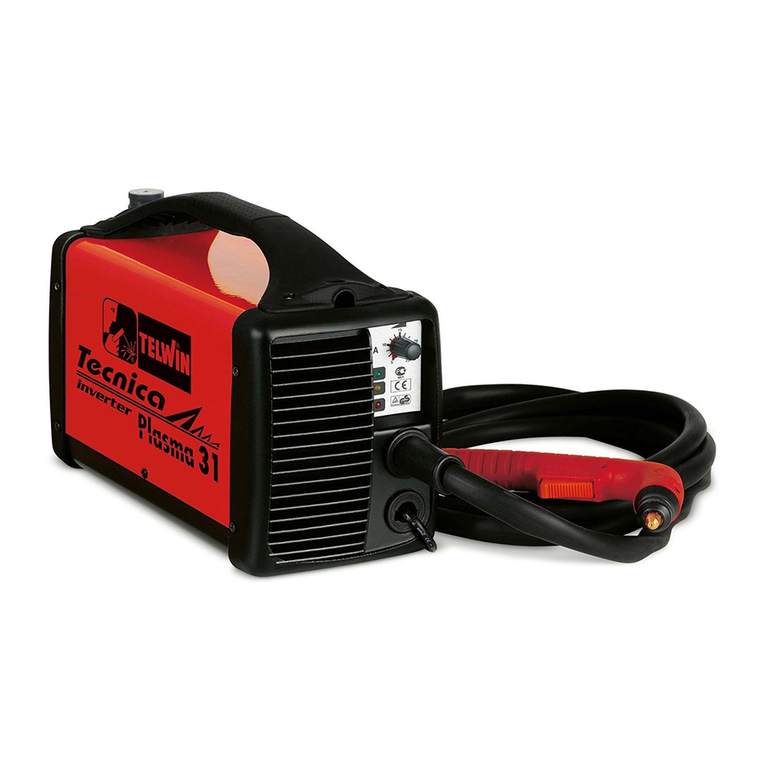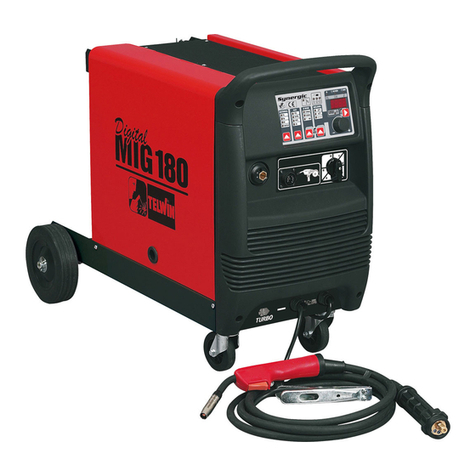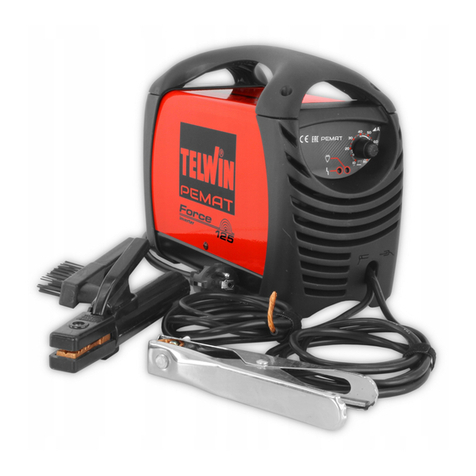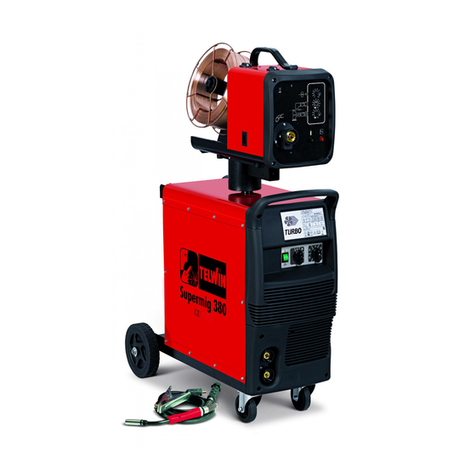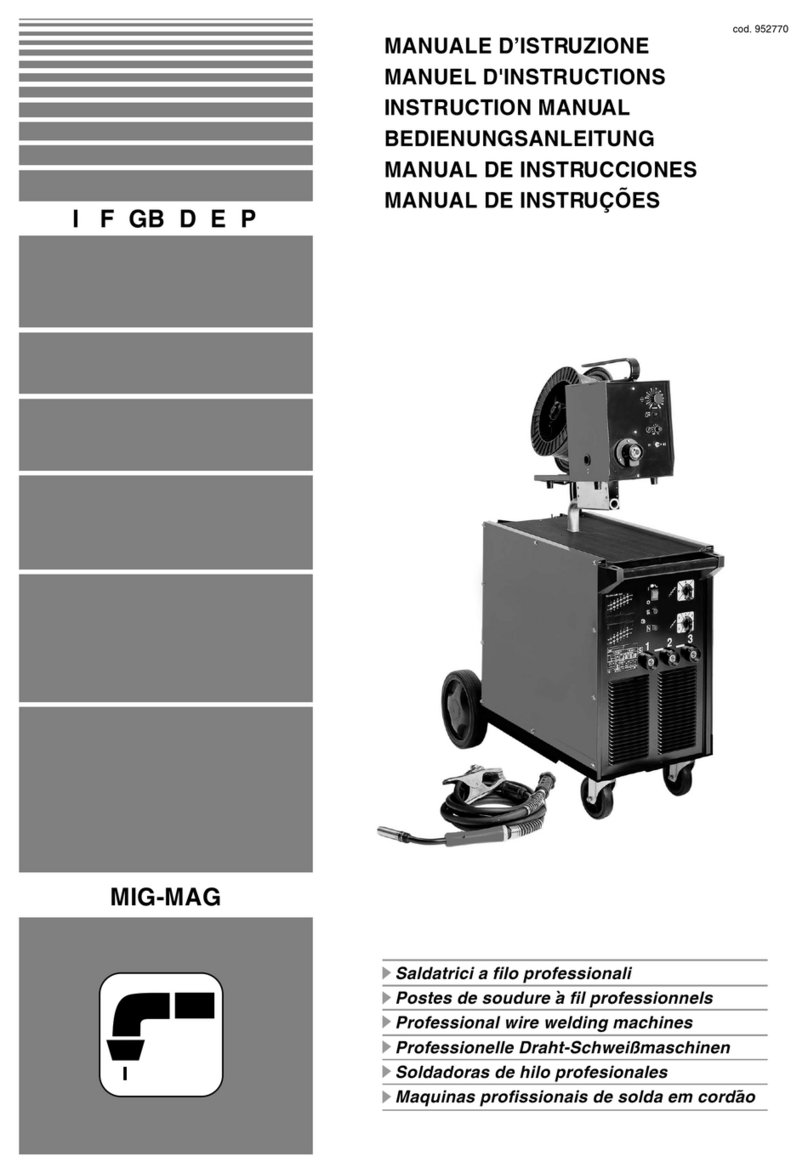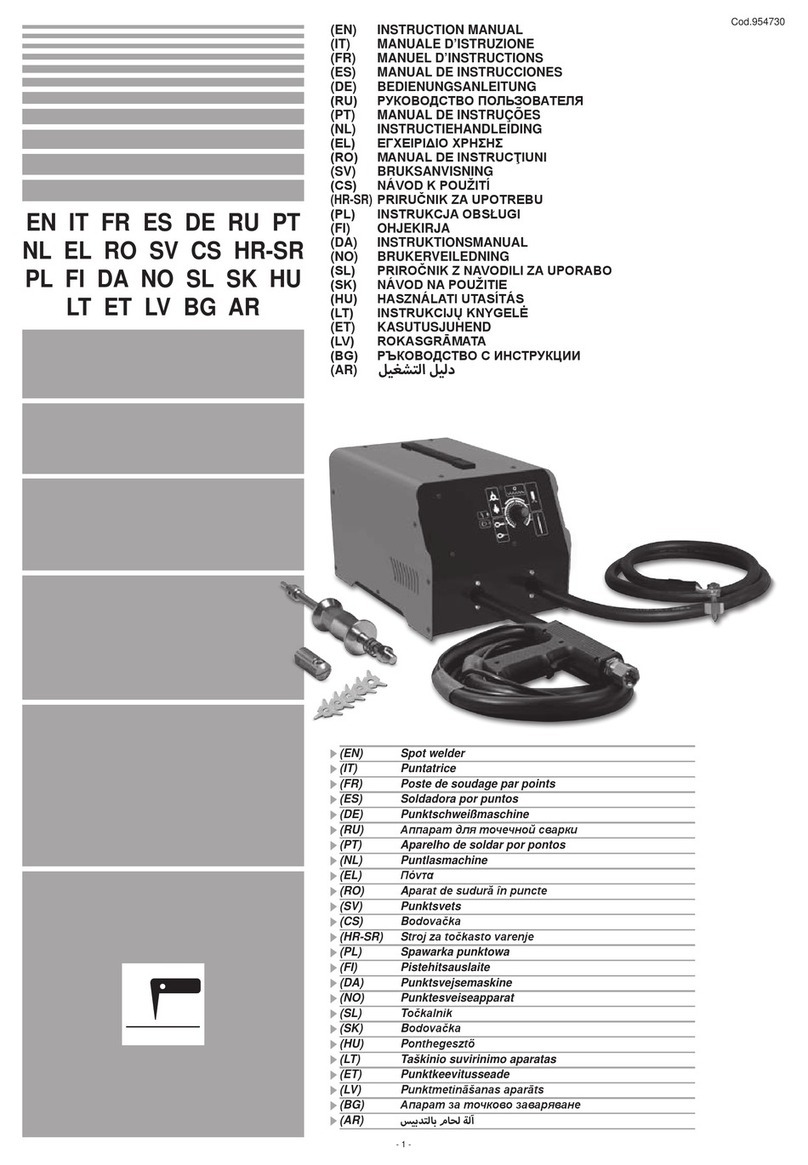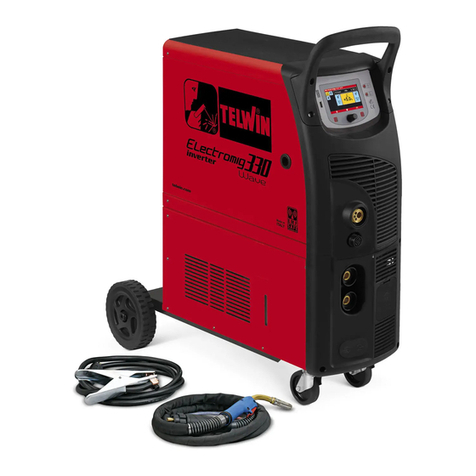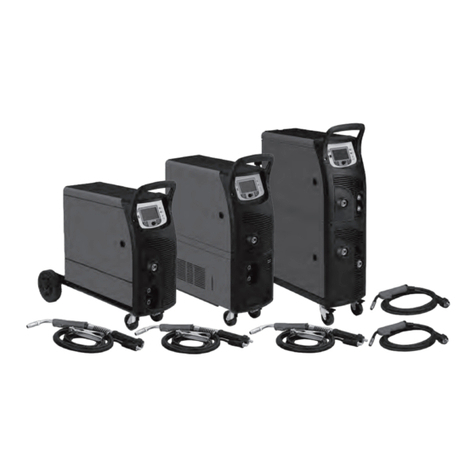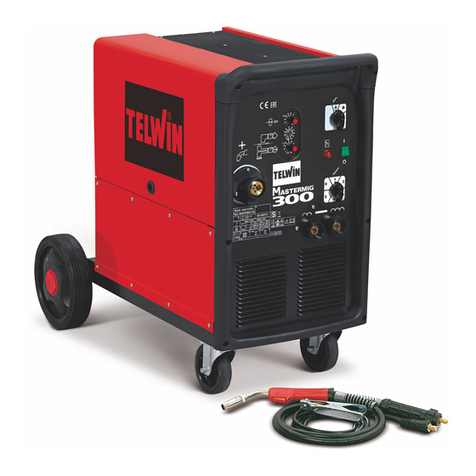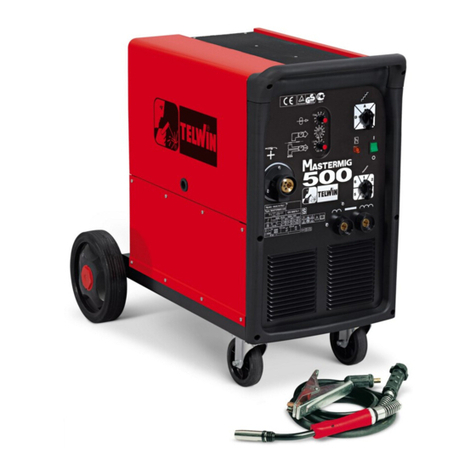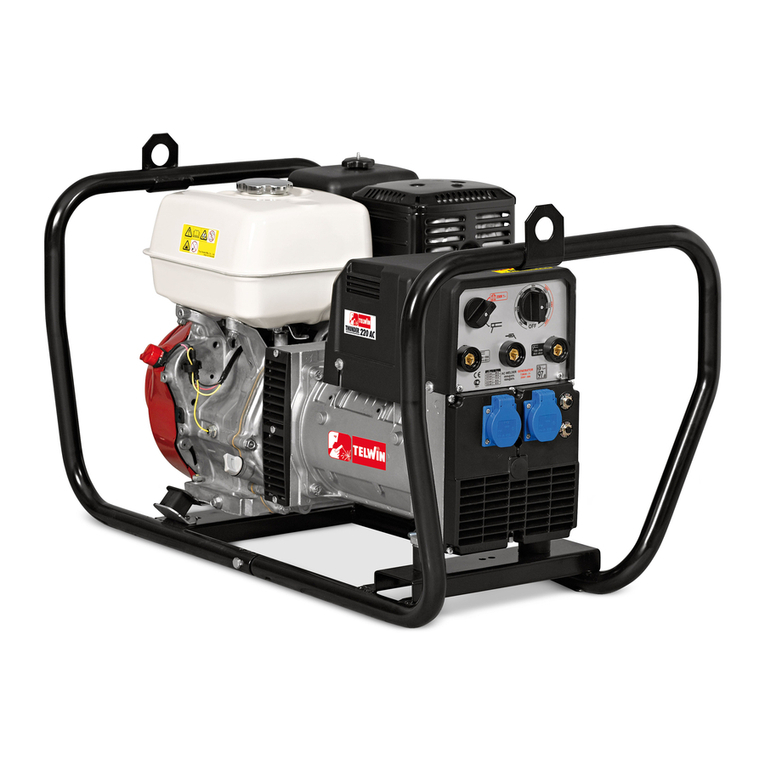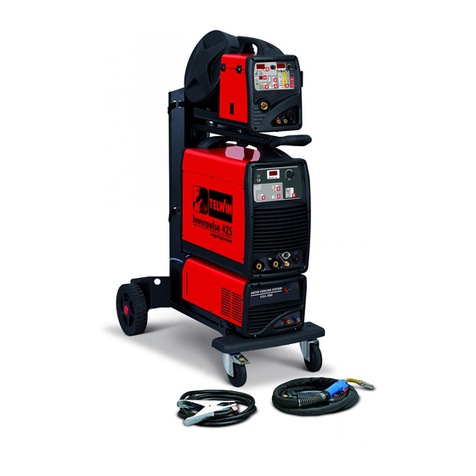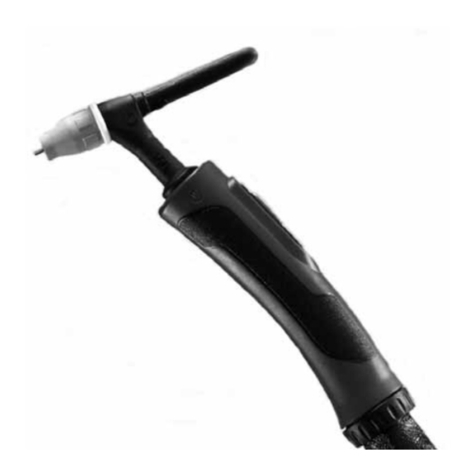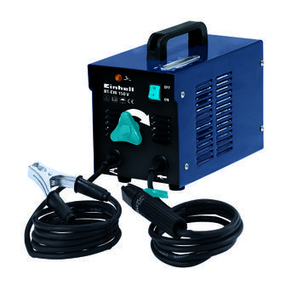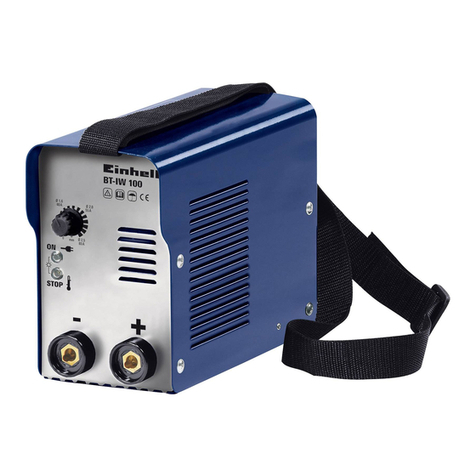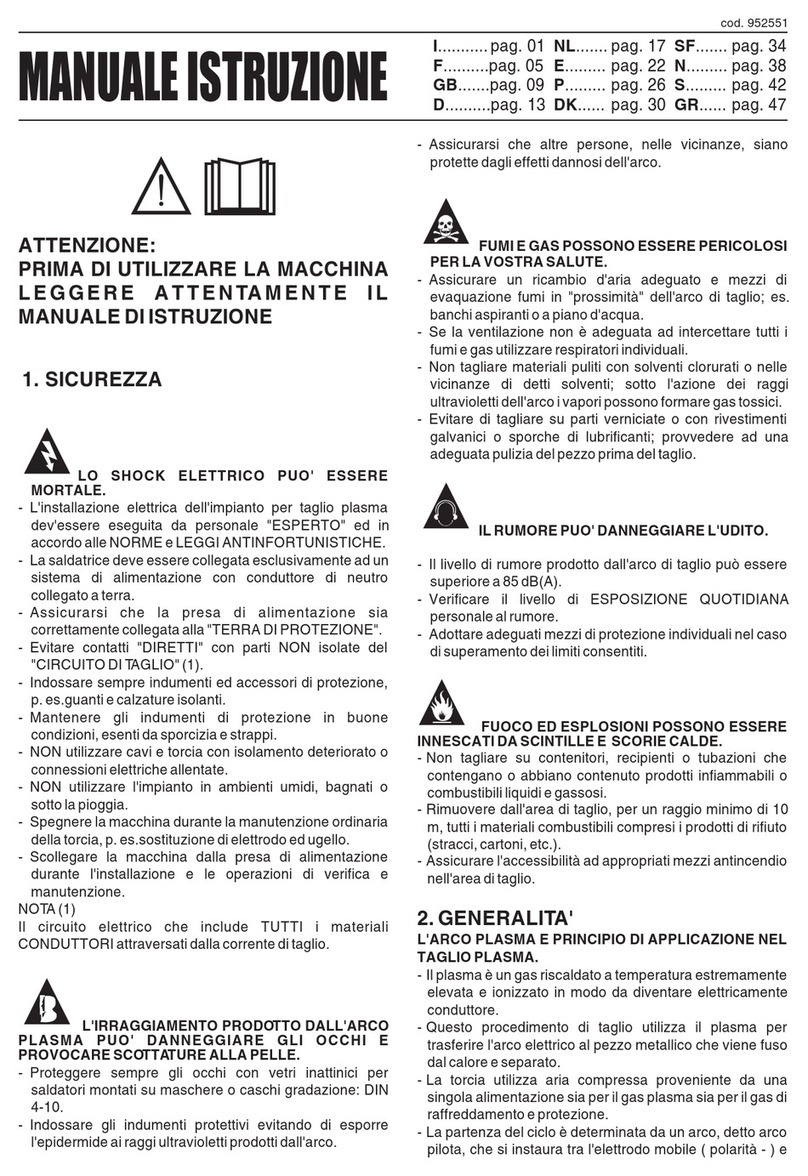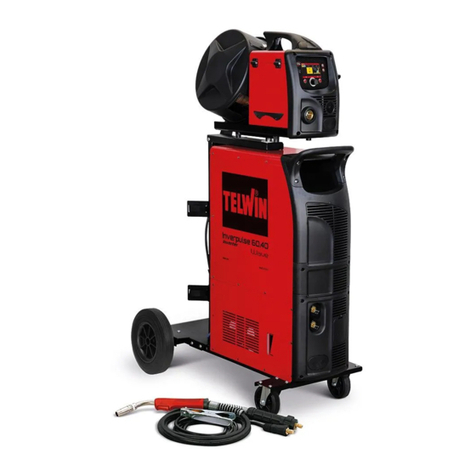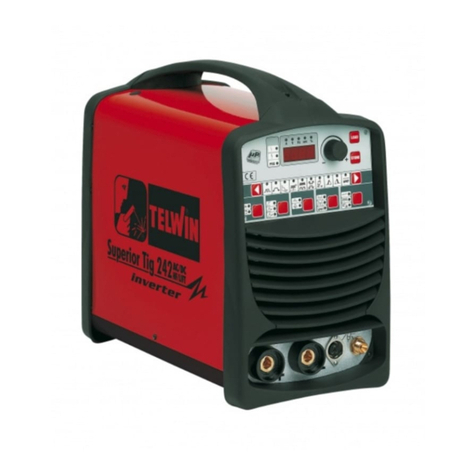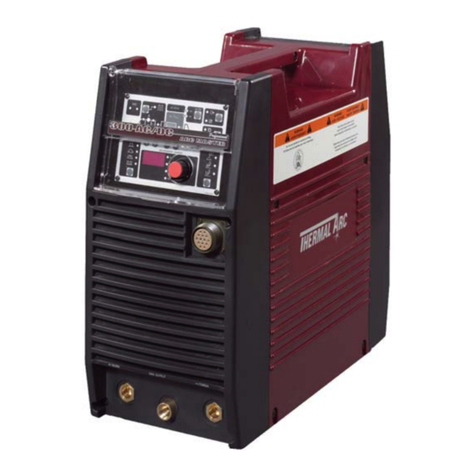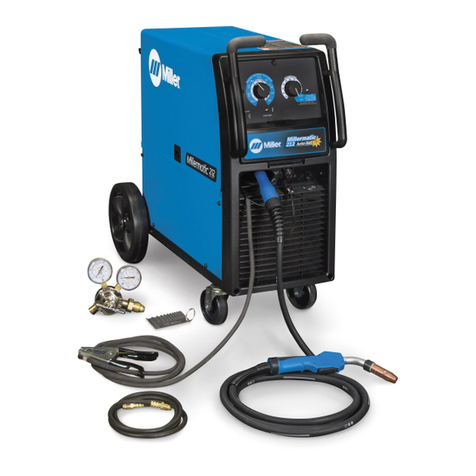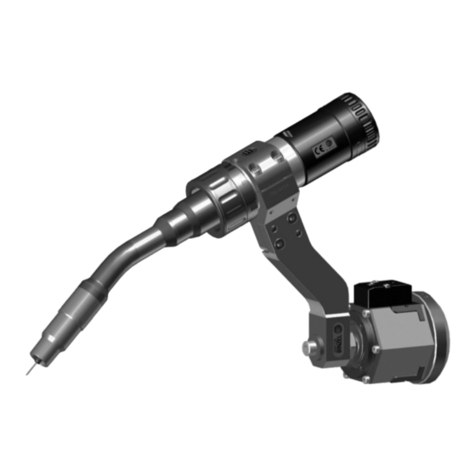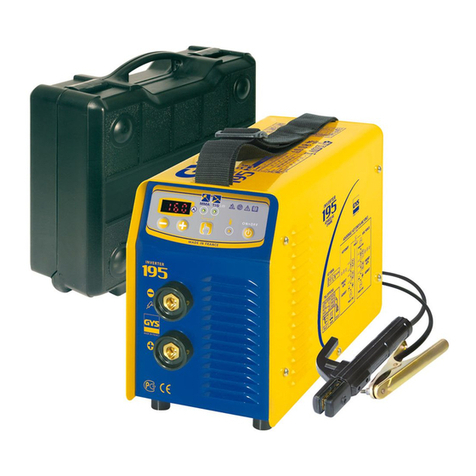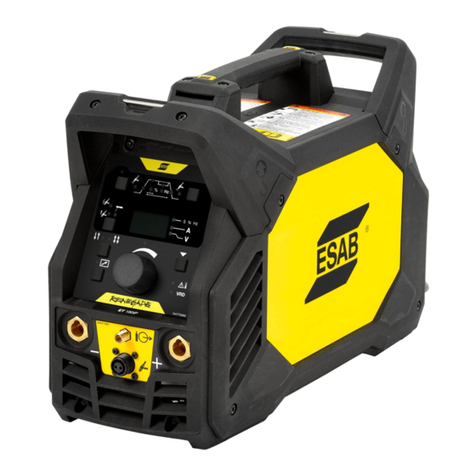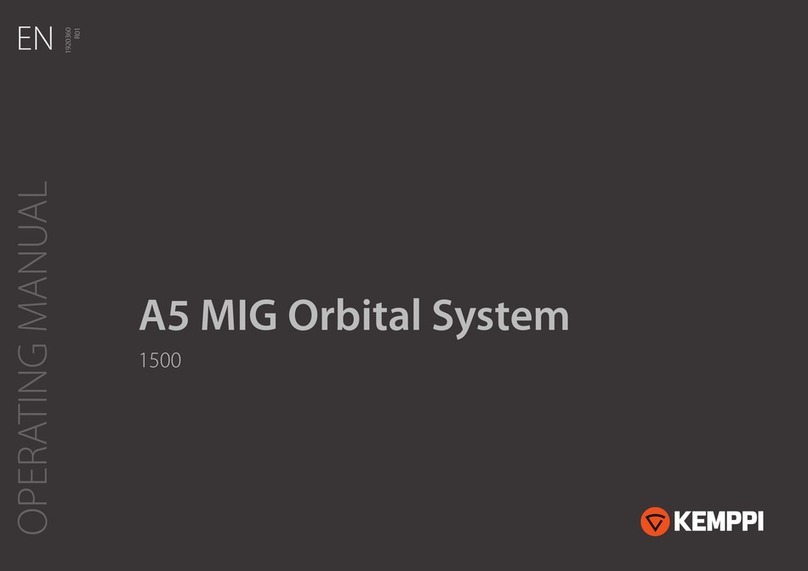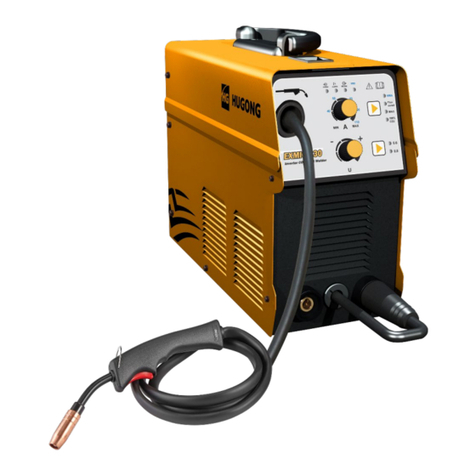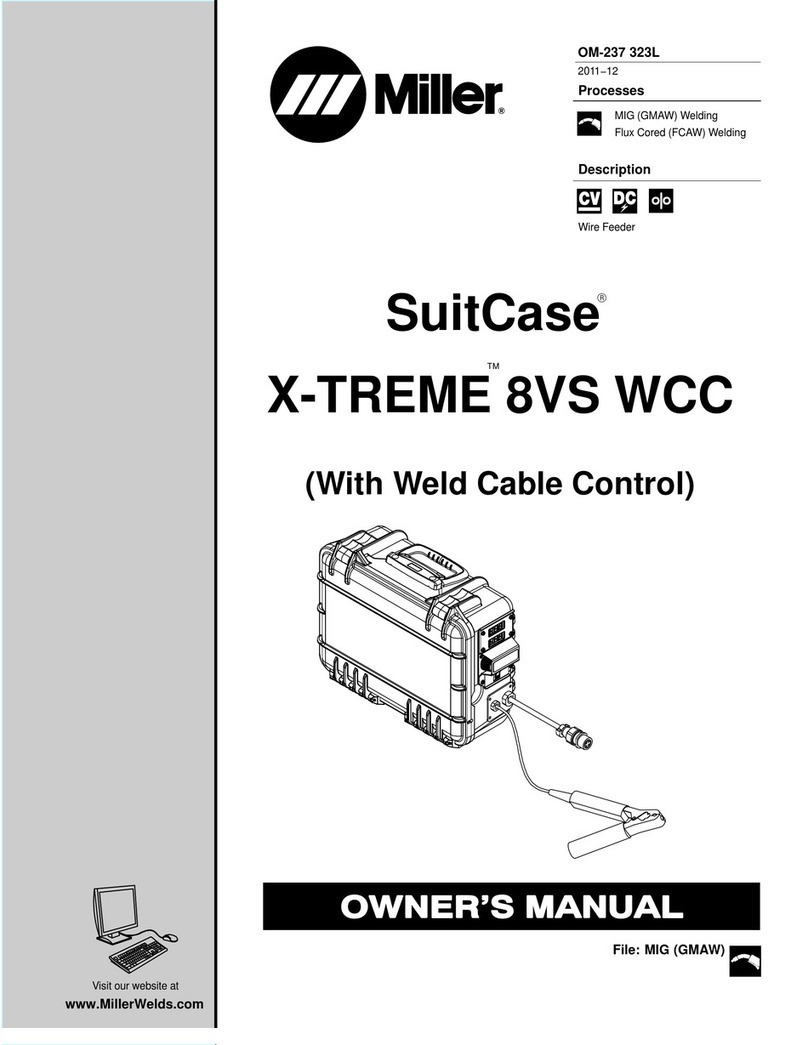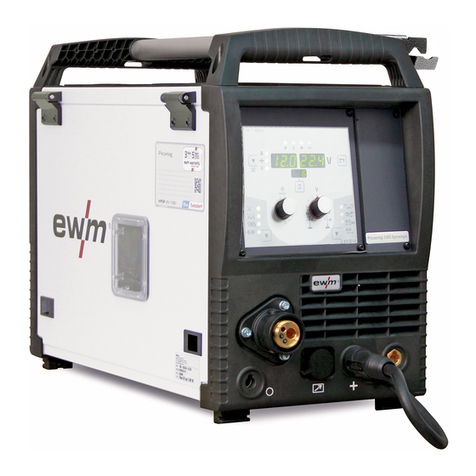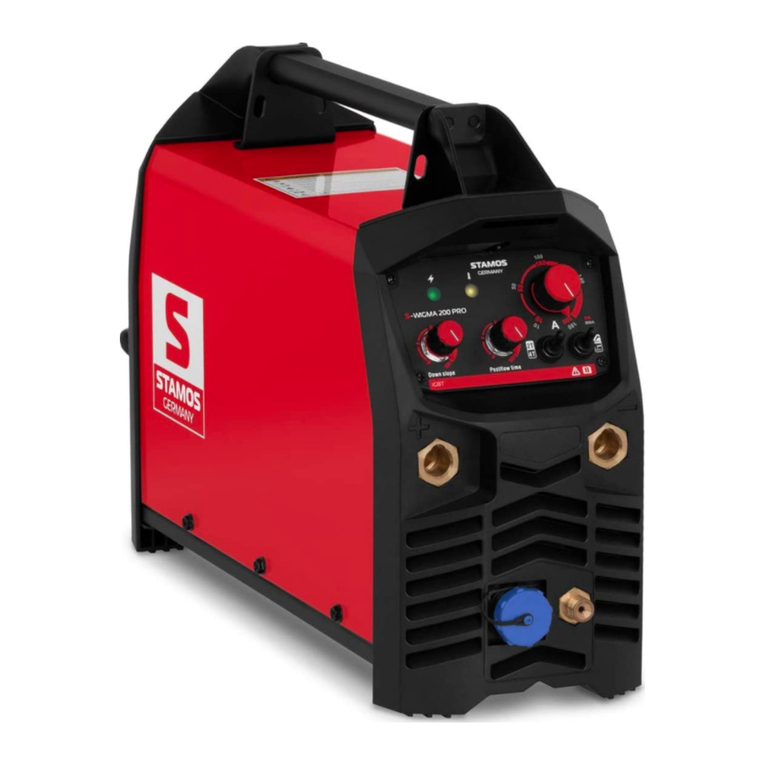
- 9 -
6.3AUTOMATICSPOTWELDINGPROCEDURE
This function is available with the pneumatic “C” clamp that is supplied with the
machine as standard.
Select the “AUTOMATIC” mode using the “MODE” key to enter the preliminary
“ZEROING” procedure.
To zero correctly, keep the clamp pushbutton pressed for all the time necessary
following the indications given on the display, then proceed as follows:
- Place the arm electrode against the surface of one of the two panels to be welded.
- Press the pushbutton on the clamp to:
a) Close the panels between the electrodes.
b) Start the spot welding cycle with the current passage signalled by the LED on
the control panel.
- Release the pushbutton a few moments after the LED has switched off.
- Afterspotwelding,theaveragespotweldingCurrent(excludingthestartandend
slopes), the Force at the electrodes and the spot welding time are displayed.
A“warning”canbeaddedtothedisplayedvalues,signalledbytheredashing
LED of the clamp (see TAB. 1), on the basis of the result obtained with the spot
welding.
- Whennishedworking,placetheclampinitssupportonthetrolley.
To zero again, press the “MODE” key repeatedly until “ZEROING” appears on the
display;toexitfromthisprocedurewithoutzeroing,pressthe“ESC”key.
IMPORTANT:
Forgoodautomaticspotweldingresults,repeatzeroingwhen:
- Theelectrodesarereplaced;
- Theelectrodesarecleaned(advisableafterapprox.30spots);
- Thearmischanged;
- Theweldingstyleischanged.
WARNING: during zeroing the clamp carries out a special spot
welding cycle where current is issued and the electrodes are closed several
times.Respectalltheindicationsgiveninthe“GENERALSAFETY”paragraph
OFTHISMANUAL!
6.4SEMI-AUTOMATICORMANUALSPOTWELDINGPROCEDURE
Operations valid for all tools, starting from the “Easy, Pro, Multi” modes:
- Select the panels to be welded (material and thickness) using the encoder.
- Look at the pre-set spot welding parameters (Fig. C-1).
- If required, personalise the spot welding program (see paragraph 6.2.4).
6.4.1PNEUMATICCLAMP
- Select continuous or pulsed spot welding (Fig. C-2).
- Place the arm electrode against the surface of one of the two panels to be welded.
- Press the pushbutton on the clamp to:
a) Close the panels between the electrodes.
b) Start the spot welding cycle with the current passage signalled by the LED
on the control panel.
- Release the pushbutton a few moments after the LED has switched off.
- Afterspotwelding,theaveragespotweldingCurrent(excludingthestartandend
ramps), and the Force at the electrodes are displayed.
A“warning”canbeaddedtothedisplayedvalues,signalledbytheashingred
LED on the clamp (see TAB. 1), on the basis of the result obtained with the spot
welding.
- Whennishedworking,placetheclampinitssupportonthetrolley.
WARNING:presenceofdangerousvoltage!Alwayschecktheintegrity
oftheclamppowercable;theprotectivecorrugatedconduitmustnotbecut,
broken or crushed! Before and while using the clamp, make sure the cable
remainsawayfrommovingparts,heatsources,cuttingsurfaces,liquids,etc.
WARNING: the clamp holds the transformation, insulation and
rectifyingsetsnecessaryforspotwelding;ifthereareanydoubtsonclamp
integrity(becauseoffalls,violentknocks,etc.),disconnectthespotwelderand
consultanauthorisedtechnicalservicecentre.
6.4.2STUDDERGUN
WARNING!
- Toxorremovetheaccessoriestoorfromthegunchuck,usetwoxedhead
spannersinordertopreventthechuckfromrotating.
- Whenworkingon doors orbonnets,youmust make theearthconnection
ontheseparts soastoprevent current frompassingthroughthe hinges,
andinanycasetheconnectionmustbeneartheareabeingspotwelded(if
thecurrenthastotravellongdistancesthiswillreducetheefciencyofthe
weld).
6.4.2.1Connectingtheearthcable
a) Remove all traces of dirt, paint, etc. from an area on the plate that corresponds to
the contact surface of the earth bar, then take the completely clean plate as close
as possible to the point where working is to be carried out.
b1) Fix the copper bar to the cleaned panel surface using an ARTICULATED
GRIPPER (welding model).
Inalternativetomethod“b1”(difculttocarryout)use:
b2) Spot weld a washer to the surface of the previously prepared panel; move the
washer through the copper bar slit and lock it with the supplied clamp.
Spotweldingthewasherforxingtheearthterminal
Fit the relative electrode (POS. 9, Fig. I) to the gun chuck and insert the washer
(POS.13, Fig. I).
Place the washer in the selected area. Place the earth terminal in contact in the
samearea;pressthegunpushbutton,activatingweldingofthewashertobexedas
described previously.
Spotweldingscrews,washers,rivets
Fit the gun with the correct electrode, insert the element to be spot welded and place
it against the panel at the required point; press the gun pushbutton: release the
pushbutton only after the set time has passed (LED switches off).
Spotweldingpanelsononesideonly
Fittheelectrodetobeusedontothegunchuck(POS.6,g.I),pressingonthesurface
to be spot-welded. Press the gun pushbutton, and release it only after the set time has
passed (LED switches off).
WARNING!
Maximumthicknessofpanelthatcanbespotwelded,ononlyoneside:1+1mm.This
type of spot weld cannot be used on body supporting structures.
Some essential precautions must be taken to obtain correct results when spot welding
plate:
1 - The earth connection must be impeccable.
2 - The two parts to be spot welded must be cleaned from all traces of paint, grease,
oil.
3 - The points to be spot welded must be in contact with each other, without gaps; if
necessary press with a tool, not the gun. Pressure that is too strong causes bad
results.
4 - The piece to be machined must not be thicker than 1 mm.
5 - The electrode tip must have a diameter of 2.5 mm.
6 - Tighten the nut that locks the electrode well and make sure the welding cable
connectors are locked.
7 - When spot welding, lightly push the electrode (3-4 kg). Press the pushbutton, and
only move yourself and the gun away from the workpiece when the spot welding
time has passed.
8 - Neverstandmorethan30cmawayfromtheearthxingpoint.
Contemporaneousspotweldingandtractionofspecialwashers
To dothis tandlockthechuck (POS4,Fig.G)againstthebody oftheextractor
(POS.1,Fig.I),connectandfullytightentheotherextractorterminaltothegun(Fig.I).
Insert the special washer (POS. 14, Fig. I) into the chuck (POS. 4, Fig. I), locking it with
the relative screw (Fig. I). Spot weld it in the relative area, adjusting the spot welder as
if spot welding normal washers and begin traction.
Whennished,rotatetheextractorby90°todetachthewasher,whichcanbespot
welded again in a new position.
Panelheatingandupsetting
In this operation mode the TIMER is disabled by default: If the welding time is selected,
the display shows “inf ”=Innitetime.
The duration of the operations is therefore manual, being determined by how long the
gun pushbutton is kept pressed.
Current intensity is adjusted automatically according to the selected panel thickness.
Panelheating
Fit the carbon electrode (POS. 12, Fig. I) onto the gun chuck, locking it with the ring
nut. Touch the area that was previously cleaned with the carbon tip and press the gun
pushbutton. Work from outside to inside, using a circular movement, to heat the panel
which becomes work hardened and returns to its original position.
To prevent the panel from tempering too much, treat small areas and pass a wet cloth
immediately over the worked area, which cools the treated part.
Panel upsetting
Panelsthathavedeformedinareascanbeattenedinthis positionandusingthe
relative electrode.
Intermittentspotwelding(Patching)
This function is suitable for spot welding small rectangles of panel for covering holes
caused by rust or other causes.
Fittherelativeelectrode(POS.5,Fig.I)ontothechuck,andcarefullytightenthexing
ring. Clean the involved area and make sure that the piece of panel to be spot welded
is clean and free from grease or paint.
Position the piece and place the electrode against it, then push the gun pushbutton
and keep it pressed. Move forward rhythmically, following the work/pause intervals
given by the spot welder.
N.B.: Press lightly (3-4 kg) while working, the ideal position is a line that is 2-3 mm from
the edge of the new piece to be welded.
For good results:
1 - Neverstandmorethan30cmawayfromtheearthxingpoint.
2 - Use covering sheets with a maximum thickness of 0.8 mm, better if made of
stainless steel.
3 - Make sure your forward movements have the same rhythm as the one dictated
by the spot welder. Move forward during the pauses, stop during spot welding.
Usingthesuppliedextractor(POS.1,Fig.I)
Couplingwashersandtraction
Thisiscarried outbytting andlockingthechuck (POS3,Fig. I)totheelectrode
body (POS. 1, Fig. I). Hook the washer (POS. 13, Fig. I), spot welded as described
previously,andbegintraction.Whennished,rotatetheextractorby90°todetach
the washer.
Plughookingandtraction
Thisiscarried outbytting andlockingthechuck (POS2,Fig. I)totheelectrode
body (POS. 1, Fig. I). Insert the plug (POS. 15-16, Fig. I), spot welded as described
previously, into the chuck (POS. 1, Fig. I), keeping the terminal pulled towards the
extractor (POS. 2, Fig. I). After completing insertion release the chuck and start
traction. Finally, pull the chuck towards the hammer to slide out the plug.
7.MAINTENANCE
WARNING! BEFORE CARRYING OUT MAINTENANCE, MAKE SURE
THEMACHINEISOFFANDDISCONNECTEDFROMTHEMAINS.
Theswitchmustbelockedat“O”usingthesuppliedlock.
7.1ROUTINEMAINTENANCE
ROUTINEMAINTENANCECANBECARRIEDOUTBYTHEOPERATOR.
- adaptation/restorationofthediameterandproleoftheelectrodetip;
- replacementoftheelectrodesandthearms;
- electrodealignmentcheck;
- coolingcheckoncablesandclamp;
- condensatedischargefromthecompressedairentrylter.
- checkintegrityofthespotwelderandclamppowercable.
7.2SPECIALMAINTENANCE
SPECIAL MAINTENANCE MUST ONLY BE CARRIED OUT BY TECHNICIANS
WHOAREEXPERTORQUALIFIEDINANELECTRIC-MECHANICALAMBIT.




















